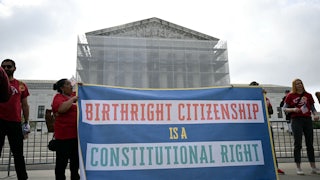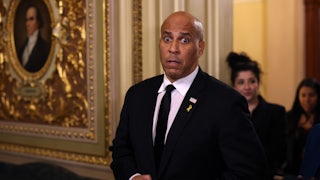Long before the Supreme Court issued its decision last week in United States v. Skrmetti, which concerned Tennessee’s ban on gender-affirming care for minors, the Christian-right legal movement hoped the case would be a kind of referendum on medical transition for young trans people, if not on transgender rights writ large. With the justices ruling to allow the ban to stand, that movement may have prevailed. But this was not a major legal victory; it was a political victory, with major legal implications left uncertain.
You wouldn’t necessarily know that from how Skrmetti is being rewritten in real time. This rather narrow legal ruling is allegedly the result of a “gamble” made and lost by the trans rights movement, now charged with having sought the wrong rights at the wrong pace. This is a familiar narrative, unfortunately, for any politically disfavored group whose rights are debated at the court. But in this case, the notion that the trans rights movement was wrong to push this court challenge is both a departure from the facts and the story the Christian-right legal movement would prefer be told: Better for trans people to be criticized for a case they lost than for the winners to face scrutiny for depriving those people of their rights.
The question posed in Skrmetti was not about whether medical transition should be available to people under the age of 18. Rather, the court was asked, with what legal standard should we judge Tennessee’s ban on a form of medical care for some people, based only on their sex?
Tennessee argued it should be judged by a lower standard for its gender-affirming care ban Senate Bill 1, asserting it “does not classify based on sex”; the plaintiffs argued the case should face heightened scrutiny because such a ban discriminates against trans people on the basis of sex. To defend the ban, Tennessee Attorney General Jonathan Skrmetti relied on a playbook produced by the Christian-right legal movement, positioning medical transition as “experimental,” shrouded in “uncertainty,” and something young people must be protected from. To fight the ban, plaintiffs including three young trans people, their family members, and a medical provider turned to the Fourteenth Amendment and its provision that the state may not “deny to any person within its jurisdiction the equal protection of the laws.” These young people were being denied medical treatments, such as hormones and puberty blockers, that non-trans young people can still have lawfully prescribed in the state. Thus bans on medical transition are sex-based discrimination.
The Supreme Court chose to sidestep much of this, while dignifying the political project behind the ban. This ruling is “very narrow, except for the gaping hole at the center of it,” said Kate Redburn, a legal historian and incoming associate professor and director of the Center for Gender and Sexuality Law at Columbia University.
The decision in Skrmetti is narrow in the sense that it leaves much good law for trans people intact, Redburn told me, such as employment protections and other anti-discrimination law, and it also leaves the door open for state bans on medical transition to be challenged on the basis of other constitutional questions or protective clauses in state constitutions concerning rights to health care. “The court declined to decide whether or not discrimination against trans people warrants the same kind of heightened scrutiny as discrimination against other protected groups,” they said. “It’s not the end of trans rights by any means.”
The “gaping hole” is what’s concerning. The court decided that Tennessee’s ban was not an issue of equal protection because it concerned a “medical condition,” not a sex classification, and so could be judged by a lower standard. This logic could possibly be extended to bans on medical transition for adults, Redburn said, as well as to contraception, abortion, or (at least in theory) any “medical condition” related to sex. In that sense, the ruling may have provided the Christian-right legal movement other avenues to regulate other aspects of sex and gender they would like to eliminate.
This should not be a surprise: The ban at issue in Skrmetti, like dozens that were introduced across the country over the course of this decade, come from the Christian-right law and advocacy movement—such groups as Alliance Defending Freedom, the Heritage Foundation, Family Research Council, and the American Principles Project. Their coalition may be more well known now as a facet of Project 2025, but before then, such groups aligned around fomenting a moral panic about LGBTQ rights. They have rather quickly seized on youth medical transition as one more way to discredit and fearmonger over transgender people in the United States, turning a rather recent rise in cultural and political visibility into a threat to children, the family, and American values.
If anyone pushed for too much too fast, it was these groups. They courted the state legislators to raise questions about medical transition, offered model legislation banning hormones and puberty blockers for minors, and defended the bans for them in court. They constructed the “misinformation to legislation” pipeline. In just five years, they wielded their bans on gender-affirming care for young people as a proxy war on trans people’s existence, passing them in 25 states. And then they pushed one all the way to the Supreme Court.
They did this. Trans people did not.
That a case like Skrmetti made it to the Supreme Court so swiftly is evidence of the success of the coalition of Christian-right, Christian nationalist, and far-right groups (to the extent that such distinctions are credible) that have been working overtime to scapegoat transgender people. These are also not new groups, for the most part, but they have been adapting to new political terrain.
Over the past decade, Christian-right groups that saw Obergefell as a crushing blow to their side have dedicated themselves to mainstreaming a new twist on an old narrative: that children are in danger and the threat is transgender people, who, by existing where children may perceive them, can make children trans. The “solution” they offer is to prevent more trans people from existing, including preventing young people from transitioning. They are very direct about this: “Transgenderism must be eradicated from public life entirely,” Daily Wire commentator Michael Knowles said in a speech at the Conservative Political Action Conference in 2023. Even when they wrap this campaign in concern for children, as those pushing the bans on gender-affirming care almost always do, sometimes they slip and acknowledge that the “endgame” is banning medical transition for all trans people.
In terms of this political project, the more revealing decision in Skrmetti was the Sixth Circuit Court of Appeals ruling. It opened with several pages offering a supposed history of medical transition, referring to the “novelty of these treatments” for young people—hormone therapy, puberty blockers, and surgery—and the “medical and unscientific uncertainty” surrounding them. But as was substantially detailed in a historians’ brief later filed in support of the Skrmetti plaintiffs, “these gender-affirming medical interventions are well-established, mainstream forms of health care.” Contrary to the Sixth Circuit’s claim that such care was first offered to young transgender people in the U.S. in the 1990s, young people have sought and received those treatments from medical providers in this country since at least the 1960s, while surgery and hormone therapy have been part of medical transition going back nearly a century. What has changed since the 1990s is there are more people providing that care, and that is what these bans are meant to reverse.
The mainstreaming of this Christian-right legal movement narrative of novelty and uncertainty is at the heart of the Tennessee ban and Skrmetti, as flimsy as it is. But such pseudoscientific arguments against medical transition for youth only had to survive in court for a short time in order to get this movement closer to its goals.
Some high-profile responses to Skrmetti have failed to account for that political reality. In an analysis of the case, The New York Times’ Nicholas Confessore claimed that some LGBTQ movement veterans “view the Skrmetti case as a tragic gamble built on flawed politics and uncertain science,” pitting them against a trans rights movement “consumed by theories of sex and gender that most voters didn’t grasp or support, radicalizing and calcifying its politics just as the culture wars reignited.” Those who lit the match—the Christian right—and their attack on transgender people are almost entirely absent from the piece, their decade-long campaign characterized by Confessore as a perception of “some trans activists and their allies.” It is on this shaky ground that Confessore alleged the transgender rights movement “bet its future” on Skrmetti.
“Skrmetti was a harm-reduction strategy,” said Chase Strangio, co-director of the ACLU’s LGBT & HIV Project, who argued Skrmetti at the Supreme Court. The intent, he told me this week, was “to stop the bleeding of bad case law and of catastrophic material consequences for our community.” The bans were simply not stopping—zero to 25 states in five years.
The idea that the trans rights movement was moving “too fast” or asking for “too much,” Strangio told me, “fails to account for the alternative—letting our community suffer terribly—and also ignores the fact that it was a right-wing, billion-dollar movement that thrust these fights into the political and judicial spheres.” That movement was merely gestured at in two paragraphs of the Times story. One leading anti-trans group, the American Principles Project, was named, but they are cast as part of “a powerful counterattack,” whose campaign against trans rights was merely responding to “a deep undercurrent of public unease.” There is no discussion of how such groups strategically fed that unease.
To look to the courts to reduce the harm caused by the law is not the same thing as looking to the court for justice, a distinction Strangio is very clear on. “The idea that we ‘bet’ on the Supreme Court for liberation or even equality misunderstands the reality of the backlash to Obergefell, Bostock, and Biden’s election in 2020. Whether we sat back and did nothing or fought with every tool that we have, these battles were being waged upon our bodies in federal court, state court, and in the political realm.”
So why are the leading groups pushing these bans and driving these fights absent from accounts of their own victory? Though the Times has reported before on the Christian-right legal movement’s campaign, it has proven much more obsessed with youth medical transition, about which it has raised doubts with reams of stories over the past few years. Some of these articles made it into Skrmetti: Thomas’s concurrence cited Times stories on trans youth seven times, and in amicus briefs supporting the ban, Times stories were cited 29 times. “The Times, which has pushed back against allegations of bias in its trans coverage, was referenced frequently in briefs that sought to portray the treatments as mired in questions and controversy despite gender-affirming care being backed by every major medical organization in the U.S.,” wrote Evan Urqhart at The Objective. Yet in its coverage since, Samantha Riedel wrote at Them, the Times has “continued to elide their role in enabling Skrmetti.”
Such stories, not only the barrage in The New York Times but also those that paved the way in The Atlantic, have been enormously useful to those who must stoke “uncertainty” about young people and medical transition in order to prevail. “An issue that the far right wanted questioned—in order to be eliminated—was questioned,” wrote Chris Geidner at Law Dork on the opinion. “With that, ‘uncertainty’ was manufactured.”
And with that focus on “uncertainty,” the groups behind these bans and the broader Christian-right legal movement get brushed to the margins of the story of Skrmetti, just as they wish—allowing them to portray their campaign as organic, to misrepresent their goals, to spread their version of events. The decision in Skrmetti is absolutely a win for them. But it is not fair to cast Skrmetti as some failure of the movement for trans rights. It is a political victory for the Christian right, claimed at the highest court, at the expense of trans people. There is a difference.






